I was trying in vain to catch up on some beauty news many moons ago and came across this article at Who What Wear – yet another on the history of red lipstick. There were a lot of things that bothered me about it, but the number one offense was the doubling down on the myth of Elizabeth Arden handing out lipstick to suffragettes during a 1912 march in New York City. After recognizing this claim’s veracity was murky at best, the article’s author stated, “I wanted to know more, so I went straight to the source: Elizabeth Arden, the very same global beauty brand founded by the namesake cosmetics maven.” A brand can certainly be used as a source, provided there are legitimate historical records that serve as evidence for their claims. However, in this piece there were many statements made by Janet Curmi, VP of global education and development at Elizabeth Arden, without anything to back them up. “On November 9, 1912, 20,000 women took to the streets of New York to advocate for the right to vote. Elizabeth Arden, a dedicated suffragette herself, opened the doors of her New York spa to hand out her Venetian Lip Paste and Venetian Arden Lip Pencil, before joining the suffragettes marching down Fifth Avenue as a sign of solidarity. The most striking sight was the bold red color on the women’s lips.” The accompanying photo shows suffragettes marching at the May 4, 1912 event (not November)…with nary a one wearing visible lip color. Just for funsies I reviewed some news coverage on the November march.* As with the May march, they describe quite a few details, including the exact route and the women’s clothing, but lipstick is not among any of them.
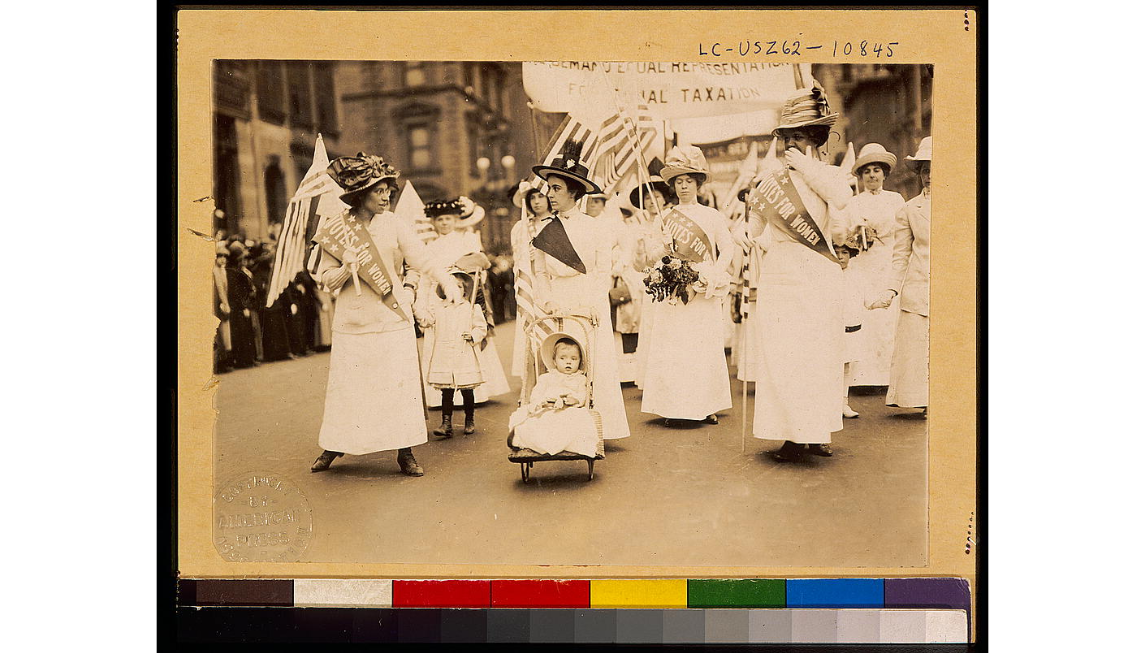
I am very interested to know where Curmi got this information. Arden wasn’t, in fact, particularly known as a “dedicated suffragist.” The legend of her providing lipsticks to marching suffragettes goes back to at least 1999 and names the May 4 rally (see Lucy Jane Santos’s outstanding effort to unravel its history, along with my findings), so November 9 appears to be a new twist on the mythos. Another addition is the reference to Venetian Lip Paste and Pencil specifically being given to suffragettes. As far as I can tell, no particular products were mentioned in the Arden suffragette story until 2021, when author Louise Claire Johnson published a book entitled Behind the Red Door: How Elizabeth Arden’s Legacy Inspired My Coming-of-Age Story in the Beauty Industry. Johnson states that Arden provided Venetian Lip Paste and pencil to the crowds at the November march, but does not cite an exact source: “However, six months later, on November 9, 1012, Elizabeth could no longer sit idly by in silence. Shuttering the salon for the day, she took to the streets and joined 20,000 women, double the size of the previous parade, and advocated for the right to vote. The most striking sight was the bold red color on the women’s lips, as they vibrantly spoke their truth. Elizabeth weaved among the masses handing out her Venetian Lip Paste and Venetian Arden lip pencil in deep red – the original ‘lip kit’. In history, it is often the slightest gestures that become revolutionary. The red lip kits were small, yet mighty weapons – a red pout in place of a middle finger against the patriarchy. Red lips were still considered illicit and immoral, so the women wore them in unison as a rebellious emblem of emancipation. Makeup was no longer a sign of sin but of sovereignty.” (p. 63-64)
While it’s been confirmed that Arden had a line of “Venetian” skincare products by 1912, her lip makeup products were still in development. There was a Venetian Lip Salve advertised in Vogue, but I’m guessing it was a clear or slightly tinted balm and not “paint”, and I could not find any mention of Venetian Lip Paste/Pencil until 1919. Additionally, 2 pages after her claim of the paste and pencil being being handed out, Johnson seems to contradict herself by stating that “after the suffrage parade, [Arden] started introducing makeup products into her Venetian skincare line.” So if the makeup was not introduced until after the parade, how was it handed out? It’s entirely possible Arden was making a prototype of these lip items available through her salons – most likely she was mixing up limited, small batches of makeup to select clients who requested it – but no ads, trademark, etc. for Venetian Lip Paste and Lip Pencil prior to 1919 seem to exist, which leads one to believe that they were not being mass produced and able to be distributed to thousands of people. Perhaps any records relating to the origins of Venetian Lip Paste and Lip Pencil and for that matter, any records of Arden giving them out at a rally are in the mysterious “Elizabeth Arden papers”, which, as one historian explains, are scattered about across the U.S. and not readily available. Still, I find it curious that the company has never provided any documentation that Arden handed out lipstick, and specific products at that. I also reached out to Behind the Red Door’s author – twice – asking for her to clarify where she came across the story of the Venetian lip products and did not receive a reply.
Curmi further embellishes the tale by remarking that mostly because of Arden, suffragette leaders began to wear red lipstick as well. “While turn-of-the-century actresses like Sarah Bernhardt and Mary Pickford helped to bring red lipstick into vogue in 1912, it was Elizabeth Arden who gave it political power, elevating it to a symbol of rebellion and female empowerment…red lips were still considered illicit and immoral at the time, so the women wore them in unison as a rebellious emblem of emancipation and defiance. [Leaders] of feminist movements such as Elizabeth Cady Stanton and Charlotte Perkins Gilman began sporting red lips as a symbol of female empowerment. Since then, red lipstick has mirrored resilient femininity.” Once again, I’m going to direct you to Lucy’s article on the subject, where she points out that Elizabeth Cady Stanton died in 1902. Continuing to wear lipstick 10 years after one’s death would be quite an impressive feat, no?
Finally, anyone who has researched makeup’s rise in the early 20th century understands there were many other factors at play in terms of how lipstick and other makeup became socially acceptable. Yes, wearing obvious makeup was certainly a seismic cultural shift and viewed as rebellious, but it cannot be credited to any one person or movement. “One of the first female entrepreneurs in 20th century America, Arden remarkably turned a $6000 investment into a billion-dollar brand. She opened the Red Door Spa on Fifth Avenue in New York City in 1910 at a time when makeup and cosmetics were considered improper. She was instrumental in changing how the world thought about beauty—the ultimate influencer,” Curmi says. These statements demonstrate the pitfalls of letting a company executive guide the narrative instead of an actual historian, as a brand employee has a vested interest in presenting their business as groundbreaking rather than telling the truth. In this case, not only does Curmi offer no hard proof for the suffragette-related claim, she conveniently leaves out the contributions of other major “influencers” of the time, i.e. Helena Rubinstein, Max Factor and Madam C.J. Walker, to say nothing of smaller brands and figures, technological advances, and economic and political factors other than suffrage. Obviously these omissions make sense as her role is to promote the Arden brand and because the reporter reached out to Arden specifically and not other companies for this article, but they also make for a rather incomplete and biased snapshot of lipstick’s history.
Finally, the subject of makeup and political power is one for another time, but for the record, most early advertising marketed it as a way to better meet white supremacist beauty standards and continue enforcing compulsory heterosexuality rather than for any “empowering” purpose. Once again, nuance is wholly neglected in favor of pushing a feel-good story that serves primarily to buoy a company’s reputation.
I’m ending this post with several requests. For journalists, one: if you must interview brand representatives, please do not rely on them as a credible source for the stories you’re trying to get to the bottom of, unless they furnish documentation from the company’s archives or other legitimate pieces of evidence. Otherwise your article runs the risk of resembling a glorified ad rather than journalism. Two: please choose another makeup topic to cover besides red lipstick (or at least, an angle not focused on cis-het white women’s history). Maybe red lipstick’s fame and status as a “classic” means stories about it get more clicks, but makeup history is so incredibly varied and rich, many other subjects would be of interest to the general public. The last plea I’m making is for the Elizabeth Arden company to show the world a shred of historical evidence that their founder provided lipsticks to suffragettes. We’re still waiting.
*These were all from the New York Times: “400,000 Cheer Suffrage March,” Nov. 10 1912, p. 1; “New States to Lead in Suffrage Parade: Army of 20,000 Expected to Participate in Fifth Avenue Procession,” Nov. 9 1912, p. 22; “Torches in Hair to Guide Parade: Electric Novelties Planned for Tomorrow’s Big Suffrage Demonstration,” Nov. 8 1912, p. 7.
I admit I purchased this object without fully understanding what it was.
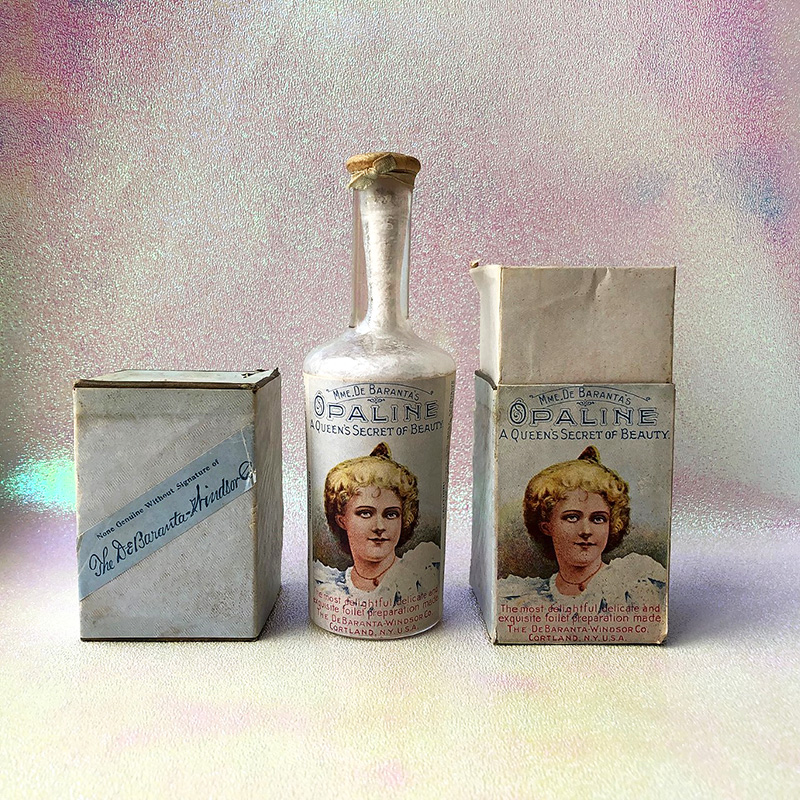
I couldn't unearth any ads for Opaline1 and very little exists about the company. There were a couple calls for De Baranta-Windsor salespeople in 1898 for totally different products – no mention of beauty preparations, so I had to rely on other clues to suss out what Opaline could possibly be. The substance appears to be a powder in the bottle, but there were a few reasons why I didn't believe it was a face powder upon closer inspection. Namely: 1. powders were normally packaged in boxes, not bottles; 2. the directions instructed the user to shake well and apply with a sponge, and powders did not usually require shaking and were applied with a puff; and 3. the directions also insinuated the product was a liquid by including the phrase "when nearly dry…".
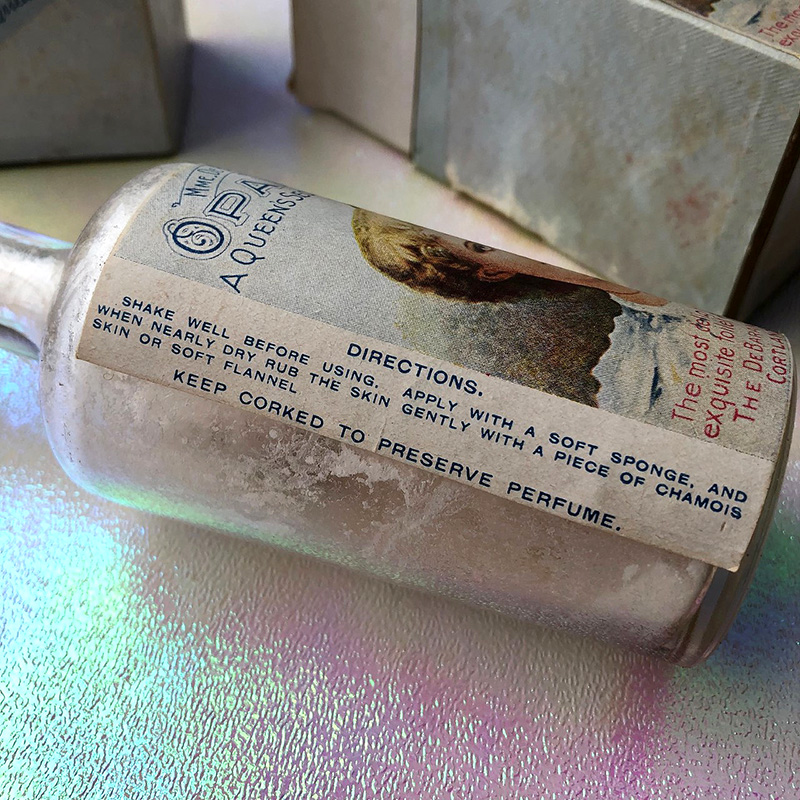
So what exactly was Opaline? Certainly not perfume and most likely not a skincare treatment either. It was clearly some kind of liquid makeup (with the liquid obviously evaporating over time) but not quite foundation as we know it today. Thank goodness for Cosmetics and Skin, as I really didn't know what I was looking at until some frantic Googling led me to their website, which has an excellent summary of the three most common types of "liquid powders" popular at the turn of the 20th century: calamine, wet white and liquid pearl (not to be confused with pearl powder).
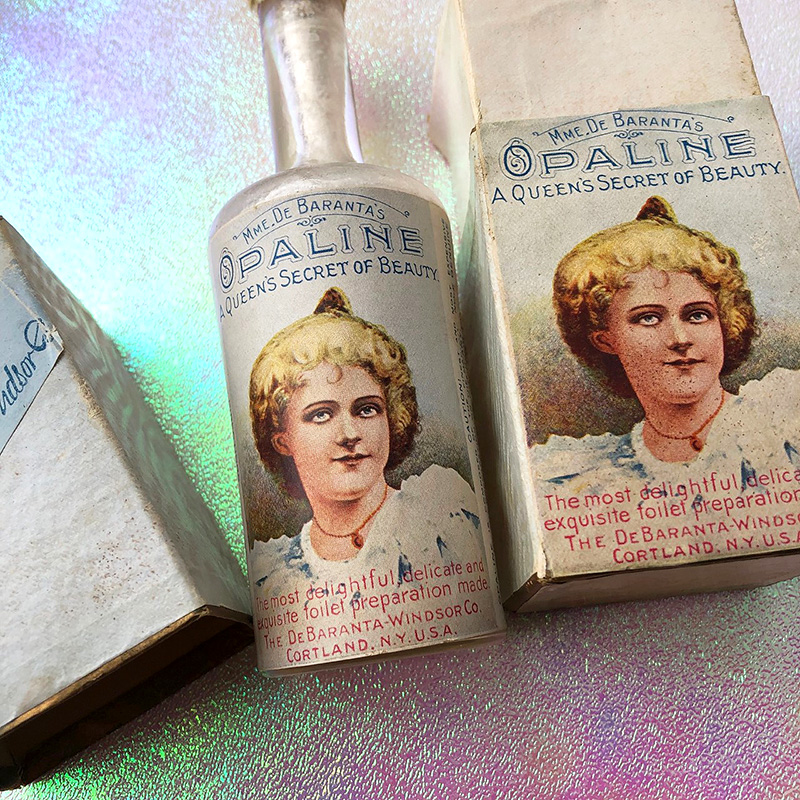
Liquid pearl was essentially white face powder mixed with water and glycerin. Despite its tendency to streak, it had several advantages over dry face powder, namely that it lasted longer and provided slightly more coverage. Although the powder component consisted of the same ingredients as face powder (usually zinc oxide or bismuth oxychloride), liquid pearl was used on the body in addition to the face, primarily for evening wear to impart an even, whitening effect on any exposed skin – ideal for the plunging necklines and short-sleeve styles of fin-de-siècle Europe and the U.S. It was also less frequently recommended as a sort of sunscreen for daytime due to the zinc. Sources detailing liquid pearl from the early 1900s align with Opaline. A 1904 recipe instructed the user to "Keep in a tightly corked bottle and apply with a sponge when required,"2 and in 1910 beauty columnist Margaret Mixter advised, "When bottled there will be a white sediment at the bottom, and the preparation must always be shaken before any is put on the face. In applying a piece of muslin or linen should be used."3 Opaline's name, color, packaging, and instructions perfectly match liquid pearl. Compare to others from the time, which were packaged in bottles and claimed to have a whitening effect.
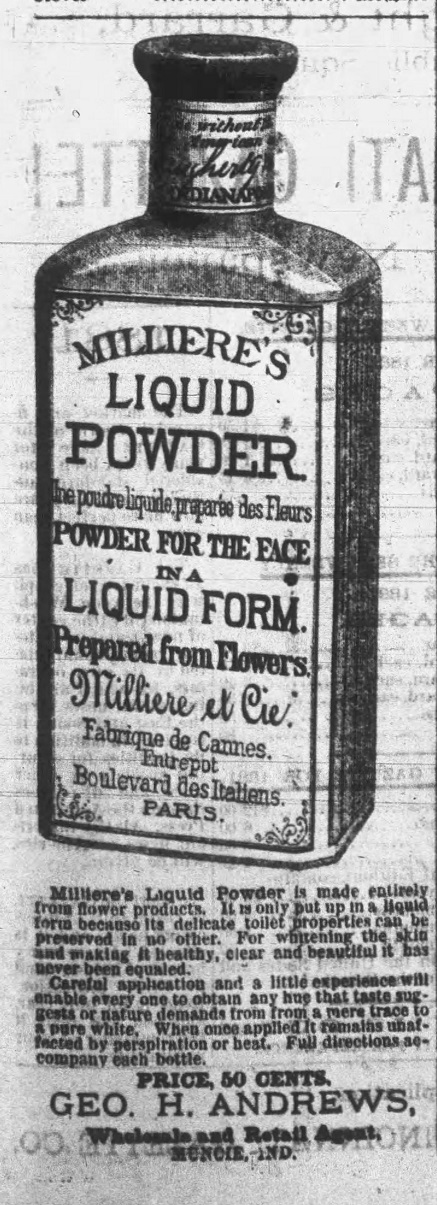
I can't uncork the Opaline bottle due to its fragility, but I was very tempted to try to sprinkle out some powder to get a sense of the texture and opacity. Instead of potentially damaging or breaking the bottle, to sate my curiosity I decided to whip up a batch of liquid pearl using a common recipe – this one appeared in a column by Harriet Hubbard Ayer4 in 1902 and was reprinted in several other beauty guides: "pure oxide of zinc, 1 ounce; glycerine, one dram; rosewater, four ounces; essence of rose, fifteen drops. Sift the zinc, dissolving it in just enough of the rosewater to cover it, then add the glycerin, next the remainder of the rosewater. Shake well and apply with a soft sponge or antiseptic gauze." All ingredients were procured via Etsy.
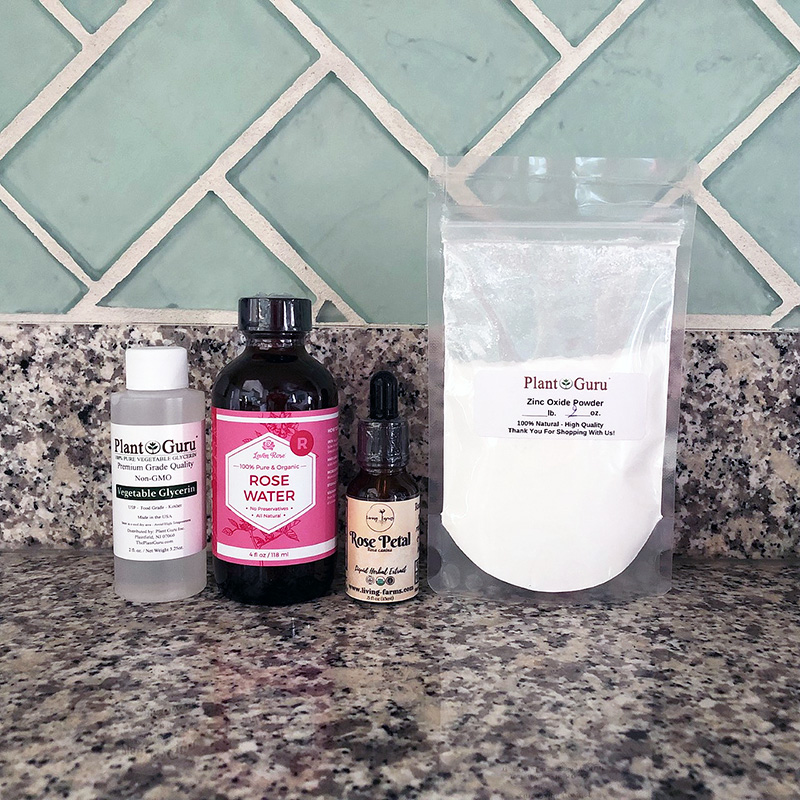
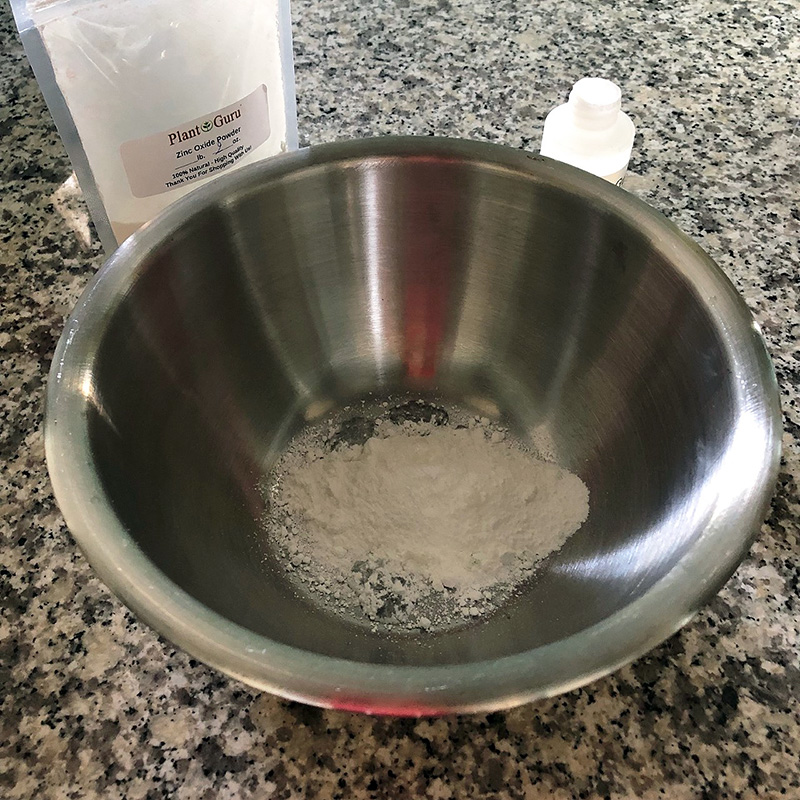
My measuring may have been off, but the mixture ended up being very thin and watery.
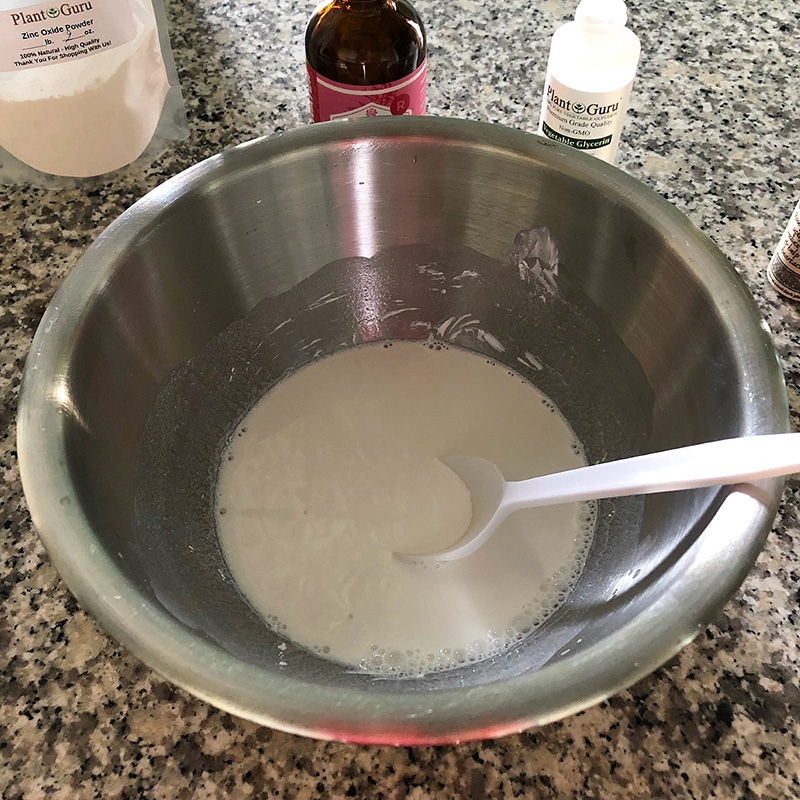
I didn't have any cheesecloth on hand to strain it nor a pretty little bottle to put it in, but I did have plenty of travel containers. After a good shake I used my trusty Beauty Blender sponge (dampened) to apply a thin layer – I was also short on linen, muslin and gauze.
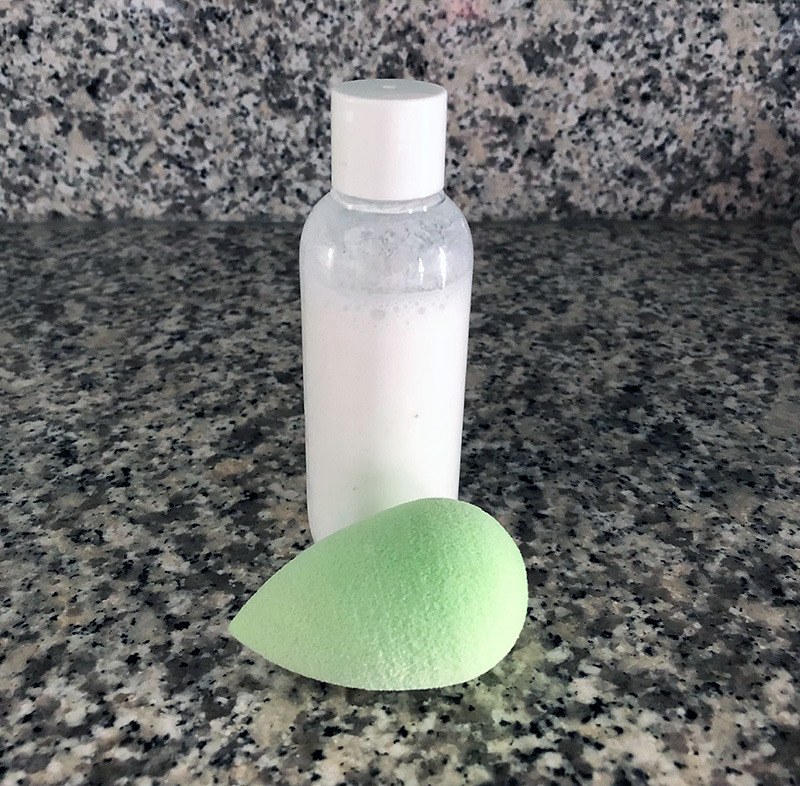
Once applied, it's actually not too dissimilar from today's zinc-based sunscreen lotion in that it leaves a pretty noticeable white cast, even with just a small amount on my pasty skin. Smelled lovely though! And the texture was surprisingly smooth and comfortable. Not as emollient as a lotion, but it didn't feel dry or like it was just sitting on top of my skin. I'm sparing you a photo, but I did try it on my face and neck in addition to my inner arm…looked quite ghostly. I also neglected to take a photo of it in the bottle a few hours after, when it had separated with all the zinc on the bottom – the instructions to shake well were definitely necessary.
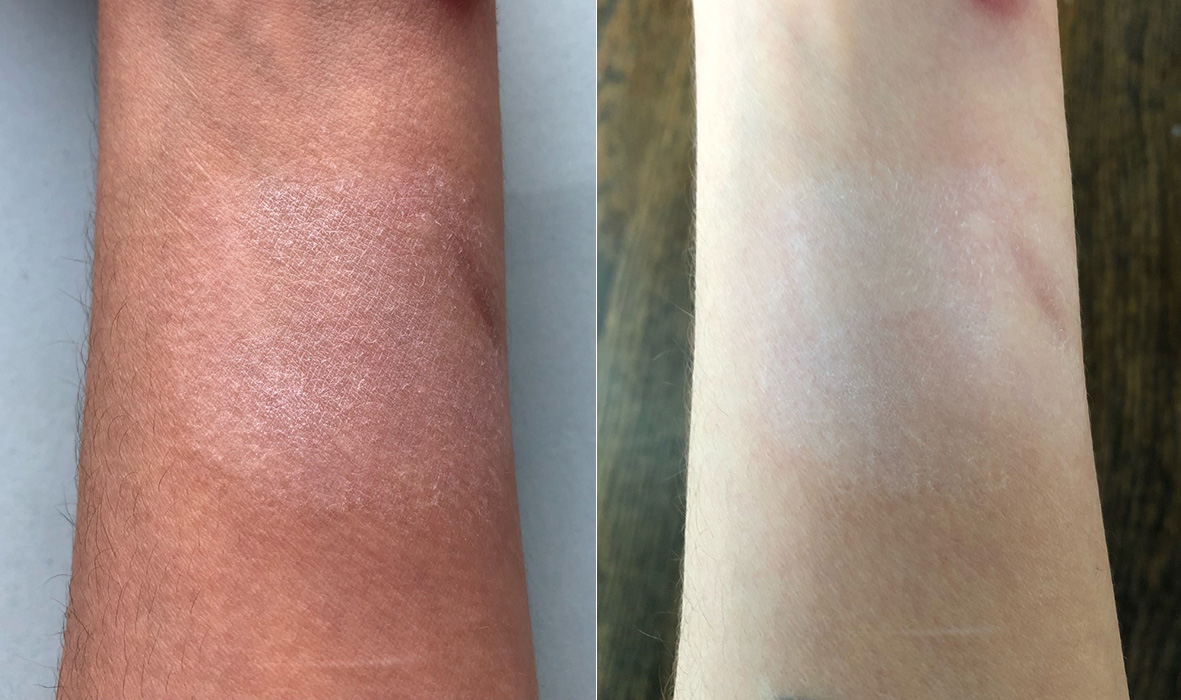
Given its unnatural appearance – I can't imagine putting on more layers – I found myself wondering if liquid pearl was commonly worn. Whiteness was (is) highly prized as a beauty standard, and liquid pearl was one way to achieve it, albeit temporarily. As was the case for centuries, the starkness of ultra-white skin wasn't an issue despite being at odds with the "undetectable" makeup that middle-class women were expected to adhere to; the whiter, the better, especially according to ads for liquid pearl. A 1914 ad for a liquid powder called Derma Viva states, "It whitens the skin at once, a single application being most effective. Red, brown or dark complexion – face, neck, arms, and hands – made a beautiful milky white by use of this wonderful beautifier."
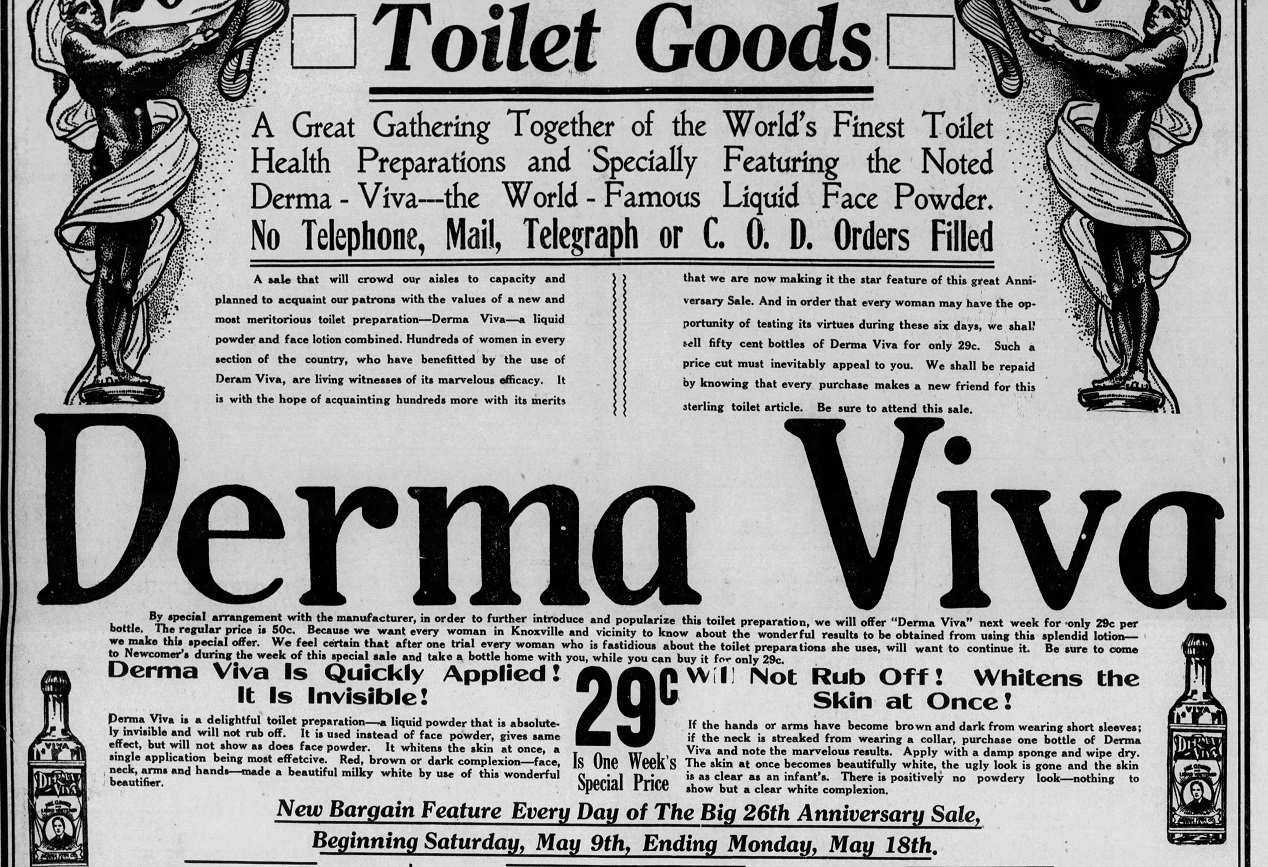
Judging from my experiment, liquid pearl doesn't seem like it would look remotely natural on even the palest of skin tones, but it appears whiteness trumped any concerns about liquid pearl's obviousness. It could also be that as there were so few formulations, liquid pearl and other liquid powders were relatively natural-looking by fin-de-siècle standards, or at least, that's what companies wanted customers to believe. Derma Viva notes that it is "absolutely invisible" and "will not show as does face powder," while Mme. Gage's Imperial Japanese White Lily, "a delicate liquid powder for evening use" was also advertised as invisible. "A successfully made-up woman does not look in the least artificial," proclaimed Mrs. Henry Symes, who then followed up this statement by a recipe for liquid pearl.5 Another column from 1903 advises using one of the new "flesh" tinted liquid powders instead of white, but notes that white powders were still preferable to the harshness of theatrical makeup. "Only a few years ago Milady was forced to be content with just two colors of face powder, chalk white and rose. Both of these were easily discernible, for they made her either too red or too pale…Not only are there fifteen tints of complexion powders, but they are put up in different forms to suit different occasions. There are liquid powders, which are to be 'shaken before taken'…at any big entertainment the women may be seen with their faces chalked till they resemble nothing so much as a company of corpses. These women do not bother about preparing the chalk; they simply take a chalk pencil and rub it into the skin with unction, and the more ghastly the result the better they are pleased."6 Given that every liquid pearl recipe dictated careful application with a sponge or other piece of cloth, it seems that as long as women were using it primarily for nighttime and paying attention to how and where they applied it, liquid pearl was an acceptable cosmetic for the average (white) woman.
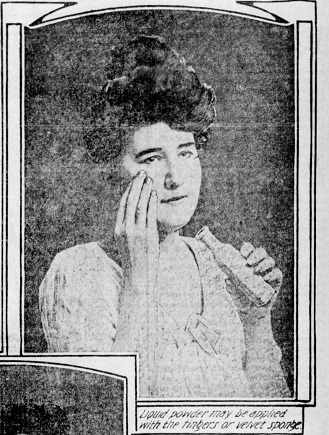
We also can't discount the fact that electric lighting wasn't totally ubiquitous at the time and liquid pearl was mostly recommended for evening wear, so perhaps it was less obvious in darkened settings. In any case, while some cosmetic recipes hold up today and all the ingredients in this particular concoction are still used in contemporary cosmetics, it appears quite crude by comparison and is best left in the 1900s.
To conclude, I'm 99.9% sure Opaline is liquid pearl, but less certain is whether Mme. De Baranta was a real person. I am skeptical! Perhaps the Cortland Historical Society, which also has this artifact in their collection, could shed some light on the company.
What do you think of Opaline and liquid pearl? And have you ever tried DIY'ing makeup? Believe it or not, this was my first experiment despite all of the recipes that have been printed in various makeup history books and seeing it done numerous times before. I think recreating old formulas would be pretty fun Makeup Museum events. 😉
1There were several instances of liquid powders named Opaline from the late 1800s/early 1900s including one by UK-based Crown perfumery and the Opaline Toilet Manufacturing Company in San Francisco, but no Opaline from the De Baranta company.
2Emily Lloyd, "The Skin: Its Care and Treatment," (Chicago: MacIntosh Battery and Optical Co) 1904, 104-105. The story of this book's author is fascinating by itself – apparently Emily Lloyd was an alias used by Ruth Maurer, who established the Marinello company. Once again, Cosmetics and Skin has all the details.
3Margaret Mixter, "Health and Beauty Hints," (New York: Cupples and Leon Company) 1910, 118.
4"Harriet Hubbard Ayer Responds to Many Inquiries Directed to the Sunday Post-Dispatch," The St. Louis Sunday Post Dispatch, May 25, 1902, 42.
5Mrs. Henry Symes, "How To Be Healthy and Beautiful: Use of Cosmetics for Improving the Complexion's Appearance – When It Is Justified," The Minneapolis Tribune, February 16, 1902. This entire column is a hoot – Symes basically calls out the hypocrisy of men judging women who wear makeup, and states that if they weren't so obsessed with certain beauty standards, women would not feel the need to wear makeup.
6"The True Uses of Powder for the Complexion," Evening Star (Washington, DC), Nov. 14, 1903, 32.
I'm still a bit wiped out from the spring exhibition and it's been ages since I've shared some inquiries that made their way in the ol' Makeup Museum Mailbag, so here's a quick review of some questions that have been sent my way.
First up is this lovely compact with a six-pointed star in blue rhinestones – perhaps a Star of David? – and matching lipstick, submitted from a reader in Australia. Her grandmother's brother had brought it back to her grandmother during the second World War. Without any logo or brand markings I can't pinpoint the company that made it, and after looking online and through all my collector's guides I can say I've never seen a vintage compact with this design. Obviously it was made in France, but I'm not quite as familiar with objects across the pond, as it were. It's a beautiful set and I wonder whether it has any wartime or Holocaust significance.

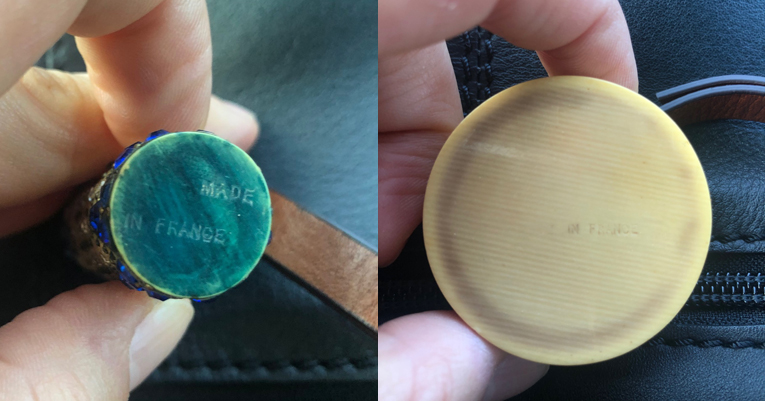
The second inquiry I have to share today was another head-scratcher. Someone had messaged me on Facebook (which I set up earlier this year but rarely use) asking about this little lady. It's a Revlon Couturine lipstick, but her identity remains a mystery.
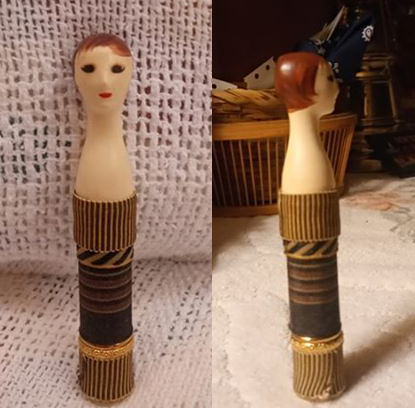
As I've noted previously, allegedly the Couturines were supposed to be modeled after actresses and other purveyors of style. But this one doesn't seem to match any of the ones that have been identified. The only other actress whose name I've seen mentioned is Shirley MacLaine but it's not her either, according to this photo.
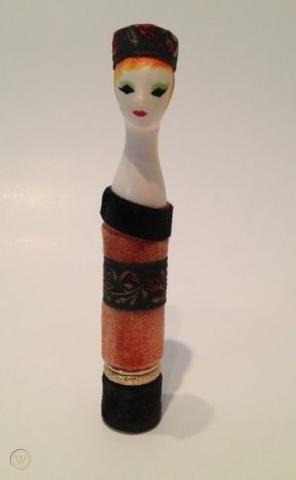
(image from worthpoint.com)
Finally, I received an inquiry from someone asking for proof that suffragettes wore lipstick as a symbol of emancipation. I swiftly directed this person Lucy Jane Santos's excellent article outlining how there really is no solid evidence that the ladies fighting for equality in the early 1900s regularly wore lipstick to rallies, or at least, to the big one in 1912. As she outlines in her article, it appears to be a persistent myth that most likely began circulating in the '90s both in Jessica Pallingston's book and Kate de Castelbajac's The Face of the Century: 100 Years of Makeup and Style (1995). Just for kicks and giggles I took a peek at newspaper archives (I'm finding they're just as fun and informative as magazines) and dug up a couple of interviews with British suffrage leader Emmeline Pankhurst and a profile of her daughter Sylvia. Their views on makeup are positively fascinating! As it turns out, Emmeline had no moral issue with cosmetics, she just didn't find a made-up face aesthetically pleasing: "Don’t think I am actually censoring the young girls nowadays…the very brief skirts and the overdone makeup are by no means an indication of loose morals. They are, in often rather a pitiful way, an indication of groping toward greater freedom and they are still more a groping towards beauty…the impulse to make one's self look as well as possible is a perfectly sound impulse. It has its root in self-respect. It is quite wrong to think that the use of short skirts and rouge are based on any violent desire to attract the opposite sex. The use of these aids [is] based on the legitimate desire to look one’s best. A woman dresses more for other women than for men. But the too-red lips and the extremely short skirt – I must confess that I dislike them. I dislike them because so few girls look well thus arrayed, and because older women, when thus arrayed, usually look rather ridiculous. But let me point out one fine fact behind all this makeup. It is not added with any idea of deception. The woman today who powders and paints does it frankly, often in public without one iota of hypocrisy. And this, I think, is a splendid gain.” (emphasis mine)
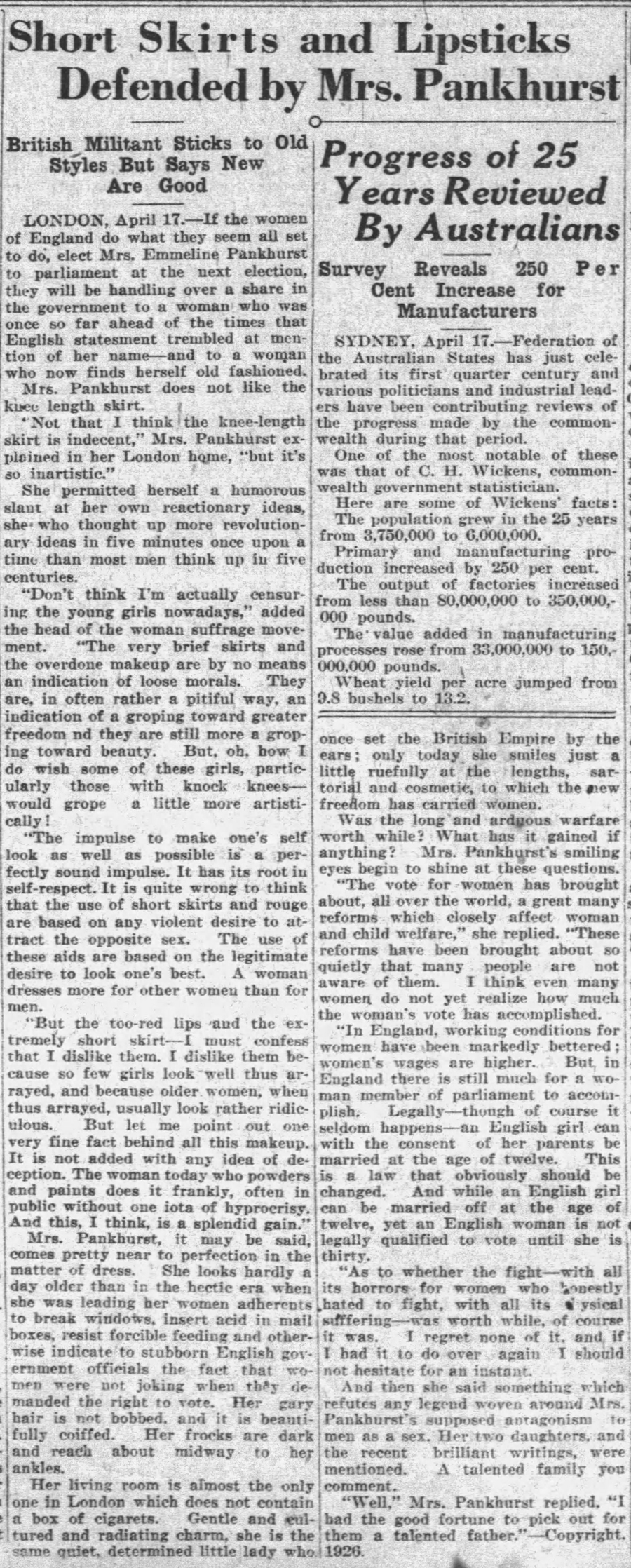
Her daughter, Sylvia, on the other hand, did not approve of makeup at all. "I still don't approve of lipstick and makeup. It's horribly ugly, destroys the value of the face. I've never used it, never shall." Her obituary also states that she thought makeup and lipstick were "tomfooleries".

I did also see this 1910 ad from Selfridge's. This is what I believe to be the only reference to suffragettes wearing lipstick. I'm wondering if this is part of how the myth was generated, since even with this ad there doesn't seem to be any concrete proof that suffragettes wore lipstick. Selfridge's advertised and sold it; whether it was widely worn by suffragettes is still up for debate in my very humble opinion.
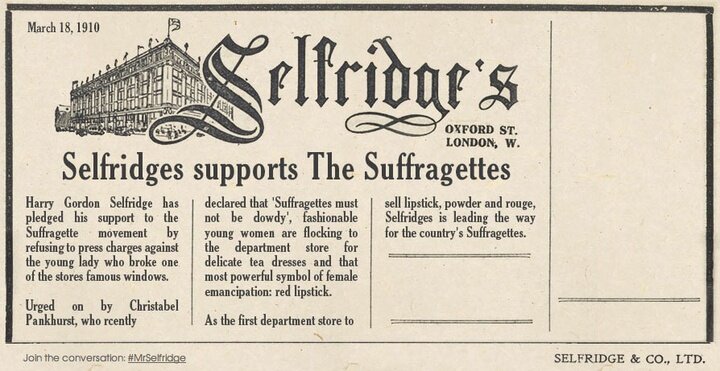 (image from @selfridges)
(image from @selfridges)
If you have any additional information about the things I've shared today, please let me know! Which one do you find most interesting?
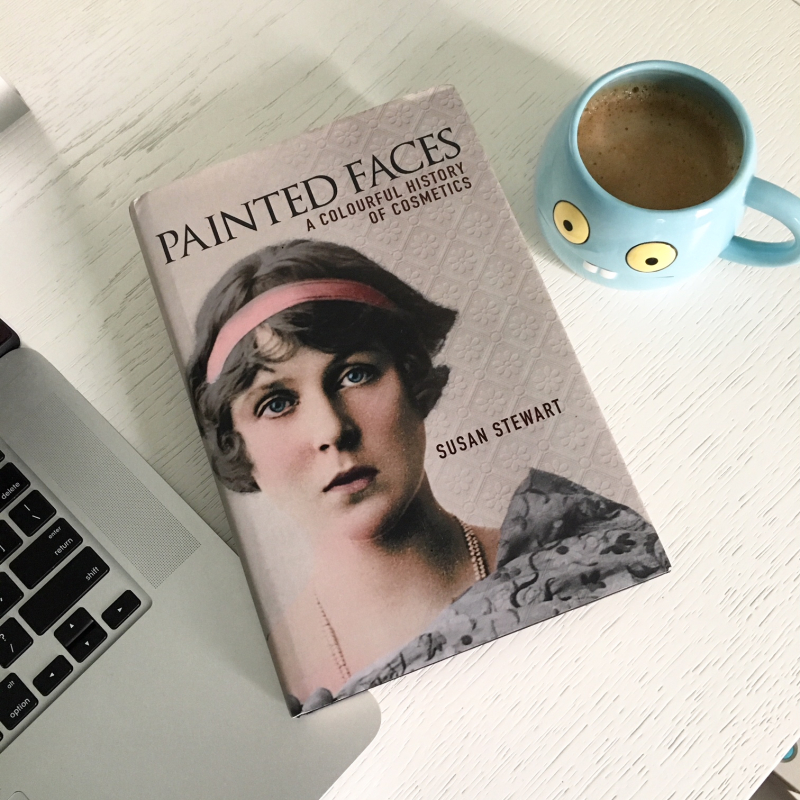
Before I get to my review of Susan Stewart's Painted Faces, I must disclose that I received a copy for free from the author. In no way, shape or form did getting it for free influence my review, nor was it intended as a bribe for a positive one – I believe I was given a copy in exchange for me lending photos of some of the Museum's collection to be included in the book. Not only did Dr. Stewart provide an autograph, she also included me in the acknowledgements, which was incredibly kind.
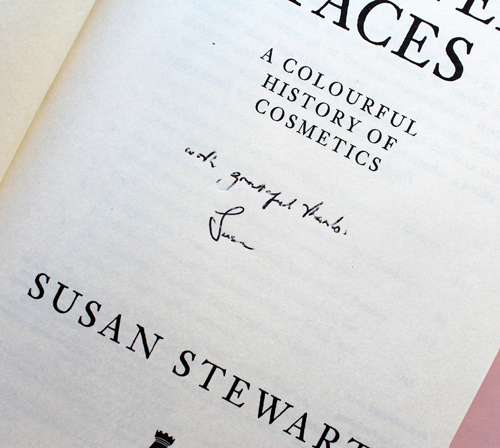

Again though, I'd like to reiterate that this did not sway my opinion of the book at all. Now that that's out of the way, I can dive into the review.
The goal of Painted Faces is much the same as Lisa Eldridge's Face Paint in that it strives to provide a history of makeup from ancient times to the present day. However, a trained scholar/historian approaches this vast topic in a markedly different way than a makeup artist such as Eldridge. Neither perspective is better or worse than the other; ways to tell the story of makeup are nearly as varied as the people who wear it. Nor do I believe one has to have a set of particular credentials to write accurately and compellingly about makeup history, as I believe it comes down to a matter of preference for a certain writing style. As we saw with her first book, Painted Faces is more academic than Face Paint and relies on highlighting the economic and sociological aspects behind various beauty practices, whereas Eldridge adopts a more artistic tone, choosing instead to communicate makeup's history by focusing on application and styles as they evolved.
Stewart begins with an introduction (which also serves as the first chapter) summarizing the need to study makeup and beauty practices as it gives valuable insight into history that we may not have considered before. "Because of its wider significance, researching makeup, its uses, ingredients, its context and application, can provide clues not only to the nature and circumstance of the individual but can also help us to interpret the social, economic and political condition of society as a whole in any given period. That is to say, studying cosmetics can further our understanding of history…they are a window into the past and can encapsulate the hopes and ideas of the future. In short, makeup matters" (p. 8 and 10). Can I get an amen?! Stewart also carefully sets the parameters for the book, outlining the sources used and why she is primarily writing about cosmetics in the Western world.
Chapter 2 is essentially a condensed version of Stewart's previous tome on cosmetics in the ancient world, which doesn't need to be rehashed here (you can check out my review of that one to peruse the content). That's no small feat, considering how thorough it was. The next chapter covers the Middle Ages, which is interesting in and of itself since so little information about makeup and beauty exist from this era. As Stewart points out, the rise of Christianity meant people were no longer being interred with their possessions as they were in ancient Greece and Rome – these artifacts provided a wealth of knowledge about beauty practices then. Thus, any time after the spread of Christianity and before the modern age historians must rely primarily on texts, such as surviving beauty recipes and classic literature, rather than objects to infer any information about the use of makeup and other beauty items. The dominance of this religion also meant even more impossible beauty standards for women and more shame for daring to participate in beauty rituals. "According to medieval religious ideology, wearing makeup was not only the deceitful and immoral – it was a crime against God" (p. 60). The other interesting, albeit twisted way Christianity affected beauty is the relentless belief that unblemished skin = moral person. Something as innocuous as freckles were the mark of the devil, and most women went to great lengths to get rid of them or cover them so as not be accused of being a witch. I shudder thinking about those who were affected by acne.
Chapter 4, which discusses beauty in the late 15th and early 16th centuries (i.e., approximately the Renaissance) presents the continuation of certain beauty standards – pale, unblemished skin on both the face and hands, a high forehead, barely there blush and a hint of natural color on the lips- as well as judgement of those who wore cosmetics. As we saw previously, it's the old "look perfect but don't use makeup to achieve said perfection" deal – women who wore makeup were viewed as dishonest, vain sinners. But one's looks mattered greatly in the acquisition of a husband, so many women didn't have a choice. "Clearly a woman had to get her makeup just right not simply for maximum effect but to avoid getting it wrong and spoiling the illusion of youth and beauty entirely, a fault that could cost her dearly in terms of wealth, status and security" (p. 94).
However, there were some notable differences between the Renaissance and medieval periods. For starters, due to inventions such as the printing press, beauty recipes were able to be much more widely disseminated than they were previously. Increased trade meant more people could get their hands on ingredients for these recipes. Both of these developments led to women below the higher rungs of society (i.e. the middle class) to start wearing cosmetics. So widespread was cosmetics usage at this point, Stewart notes, that the question became what kind of makeup to wear instead of whether to wear it at all.
This chapter was probably the most similar to those on Renaissance beauty in Sarah Jane Downing's book, Beauty and Cosmetics: 1550-1950. Given the lack of information regarding cosmetics during this time period, both authors had to draw on the same sources to describe beauty habits. However, as with Eldridge, the approaches Downing and Stewart take are slightly different. Once again, Stewart opts for a straighter historical approach whereas Downing looks more to paintings and literature of the time, and doesn't take quite as deep a dive into the larger social and economic forces at work. There's also not much overlap between the descriptions of recipes and techniques, as you'll find different ones in each book. For example, one that was mentioned only in passing in Downing's book was using egg white to set makeup. I'm thinking of it as a early version of an illuminating setting spray (although obviously it was brushed on, not sprayed in a bottle) as it lent a slightly luminous, glazed sheen. Stewart points out that it also caused one's face to crack, thereby eliminating the wearer's ability to make any sort of facial expression. It seems certain beauty treatments, whether egg white or Botox, occasionally come with the side effect of suppressing women's expression of emotion. Coincidence? I think not.
Chapters 5 and 6 are tidily sequential, discussing beauty during the the 17th and 18th centuries, respectively. As in the Renaissance, both eras witnessed significant growth in the number of women who wore makeup due to technological advances and increased trade. Growing literacy rates drove demand for the new medium of ladies' magazines. Pharmacies selling raw materials to make beauty treatments had started to crop up in the 17th century and their numbers increased dramatically by the beginning of the 18th century. Not only that, pharmacies and chemists started offering their own pre-made formulas, and these goods became commercially exported to other countries. The widespread sale of these products came with several undesirable effects: counterfeit cosmetics and downright false claims about the product's efficacy.
The 1700s also saw the rise of excessive, decidedly unnatural makeup being worn by members of the aristocracy in both France and England, followed by a post-French Revolution return to more subtle makeup in the early 1800s. This brings us to Chapter 7, which outlines the myriad changes leading to what would become the modern beauty industry, including department stores, industrialization and the new commercial market of the U.S. As for beauty standards, a natural look was still strongly preferred by both men and women, with the emphasis in terms of products on skincare rather than color cosmetics. Here's a literal lightbulb moment: despite my research on Shiseido's color-correcting powders, in which I learned some were meant to counterbalance the effects of harsh lighting, I had completely overlooked the influence of artificial light on the skyrocketing production of face powders. "Suffice it to say that in the early years of the twentieth century, the use of artificial light in homes of the wealthy as well as in public places such as theatres and concert halls would become more widespread, in the latter years of the nineteenth century there was already an understanding that to make the best impression, makeup needed adjusting to suit the light, whether it be natural or artificial" (p.198).
Chapter 8 leads us into the 20th century. While there are more detailed accounts of makeup during this time, Stewart does an excellent job describing the major cultural and technological influences that shaped modern beauty trends and the industry as a whole. I was very impressed with how she was able to narrow down the key points about 20th century beauty without regurgitating or simply summarizing other people's work. Some of the information presented is familiar, of course, but the manner in which it's arranged and categorized sets it apart. It just goes to show that everyone's individual background equals an infinite number of ways to tell the story of makeup.
I'm partial to this chapter since the items I took photos of for the book are all from the 20th century. :)

Here are some powder boxes on the dust jacket.
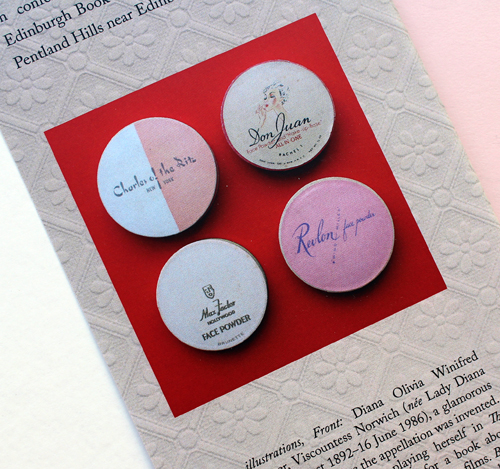
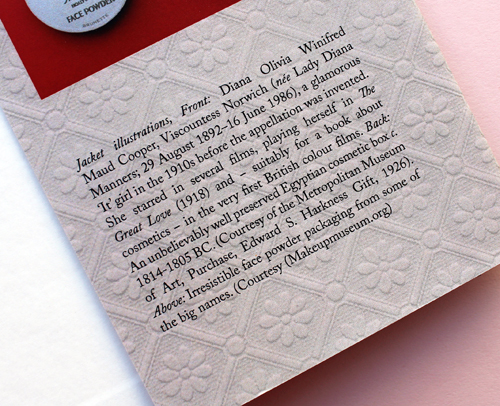
While I was deliriously happy to see some of the Museum's items in a real published book and get credited for them, I was also pleased to see photos of other pieces as well. Their inclusion in addition to illustrations was a bit of an upgrade to Stewart's previous book. This is a minor issue to be sure, as I believe solid writing more than makes up for a lack of photos, but they are a nice touch if available.
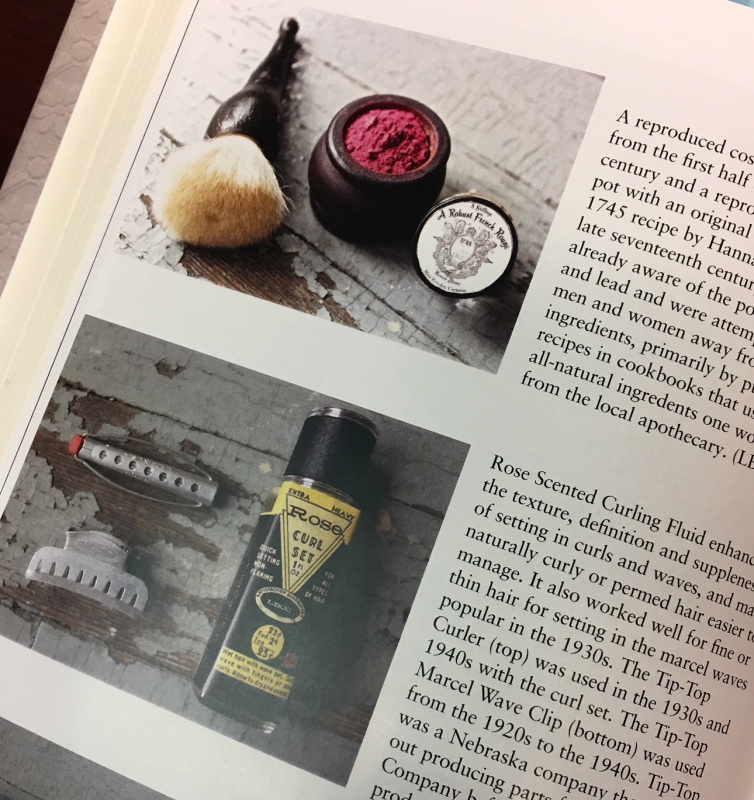
The last chapter serves as an addendum in which Stewart reflects on how the past, present and future of beauty are linked, noting that while some things have stayed the same – the use of ancient ingredients in modern formulas, the connection between health and beauty – 21st century attitudes towards cosmetics represent a significant change from earlier times.
Overall, this is a more scholarly history of makeup than we've seen before, but by no means dry and boring. Stewart's gift for wading through hundreds of historical documents and neatly consolidating the major social, economic and cultural forces that shaped makeup's history, all while sharing fascinating snippets such as ancient beauty recipes and anecdotes from people who lived during the various eras she covered, makes for a thoroughly engaging read.
Will you be picking this one up?
Save
Save
Save
Save
Save

























